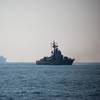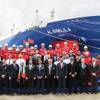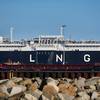Wärtsilä Corporation has successfully completed the factory
acceptance test of the first Wärtsilä 50DF engine in a series of four
dual-fuel engines for a 74,000 m3 LNG carrier.
The LNG carrier is under construction at the French shipyard
Chantiers de l'Atlantique for the French gas holding company Gaz de
France. Due for delivery in 2004, it will be powered by four Wärtsilä
6L50DF dual-fuel engined generating sets which will meet all the
ship's propulsion and shipboard electrical requirements. The Wärtsilä
6L50DF engines each develop 5700 kW at 514 rev/min.
This will be the first LNG (liquefied natural gas) carrier to be
powered by electric propulsion, and one of few to have
internal-combustion engines instead of the more usual steam turbine
plant.
The tests of the Wärtsilä 50DF engine began in Finland early November
2002. The test program is designed to verify the functioning of the
engine and for optimization of its performance. After thorough checks
of all systems and running in, the initial data measurements were
taken and the turbocharging system was optimized. The engine
performance was then measured at steps from 15 to 100 per cent load.
Adjustment of all engine functions then followed, particularly for
trip to diesel operation, transfer to gas fuel operation, load
acceptance and load rejection. The engine was tested mostly on
natural gas but it was also run on low heating value gas and on gas
with a low methane number.
The factory acceptance test was witnessed by the ship owner, the ship
operator, the shipbuilder and the classification society. The engine
also successfully passed a type approval test witnessed by
representatives from the classification society Bureau Veritas.
Both tests included operation on gas fuel and light fuel oil (LFO),
with tripping to diesel operation, transfer to gas fuel operation,
load acceptance, and load rejection. Again it was also run on low
heating value gas and low methane number gas. An important aspect was
that all safety systems were tested.
In August 2003, all four engines will be delivered to the shipyard
for installation in the LNG carrier.
Featured videos

Unlock Onboard Data Efficiencies

Tracking Foreign Vessels Working in the U.S. Jones Act Market

Inmarsat Enhances Service to Drive Digitalization
Subscribe for
Maritime Reporter E-News
Maritime Reporter E-News is the maritime industry's largest circulation and most authoritative ENews Service, delivered to your Email five times per week









